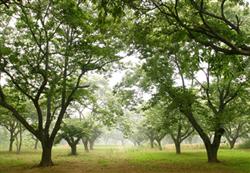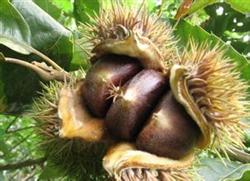Post-harvest management of Chinese chestnut

The flower bud differentiation period of the second annual yield of chestnut is from September to the first ten days of October, and the management after fruit harvest has a direct impact on the yield of the following year, so it is particularly important to do well in the four steps of "full food, drink, warm clothing and health care". First, apply fertilizer reasonably and give enough to "eat". Generally, every 100 kg of Chinese chestnut needs to consume 4.5-5 kg of pure nitrogen, 4.5-5 kg of potassium and 1.5-2 kg of phosphorus. Fertilizer should be applied in time after fruit harvest, and organic fertilizer is the main fertilizer. General 8-10-year-old trees, each ditch application of barnyard manure 50-60 kg, urea 0.5 kg, phosphate fertilizer 1 kg; more than 10-year-old trees, according to the amount of fruit and increase the amount of fertilizer. Second, irrigate water to fight drought and give enough "drink". After fruit harvest, there is a great loss of water in the tree body, and the drought in autumn and winter is generally serious in farming season, which is easy to make chestnut trees suffer from drought, so chestnut orchards with conditions after fruit harvest should be irrigated once in time, and then timely irrigation is needed in case of drought. Third, cultivate the earth to choke, and give enough "wear". In the middle and last ten days of November, each tree carries 2-4 mature garbage and pond mud according to its size, laying it under the crown with the trunk as the center, and then covering it with a layer of fine soil. Dig again when the temperature rises in the next spring, in order to aerate and grow roots, and at the same time reduce the growth of weeds. Fourth, prevent and cure pests and diseases and carry out "health care". Clear the garden in time after fruit picking, cut off withered branches, disease and insect branches, remove the disease and insect branches and leaves that fall off on the ground, and burn them or bury them deeply. In autumn, the diseases and pests of chestnut trees should be controlled timely, and pesticides can be treated with double Bordeaux solution, 1500-2000 times omethoate emulsion, 2.5% dimethoate EC 8000 times, and so on.
- Prev

Zinc and Boron should be supplemented in Postharvest Chestnut
At present, the yield of most chestnut orchards is not high, the plant yield is only 4-5 kg. Many Chinese chestnuts hang fruit trees with bracts and no chestnuts (that is, empty buds). The reason is that in addition to extensive management, it has a great relationship with the application of zinc and boron. Practice has proved that the supplementary application and spraying of zinc and boron micro-fertilizer after fruit picking of Chinese chestnut can promote flower, differentiation and improve flower quality.
- Next

Chestnut "empty shell" is well controlled
Chestnut "empty shell" is also called "empty canopy", empty shell rate can reach 30%~90%, affecting chestnut yield. The main reasons for producing empty bract of chestnut are: ① poor pollination and fertilization in flowering stage of chestnut. (2) Boron and available phosphorus deficiency in soil. 3. Influence of other factors. One is variety, different variety, male and female inflorescence quantity is different, all...
Related
- Moge, come on! The staff of the peasant association in the producing area of cantaloupe were frightened when the crowd gathered.
- Causes and Solutions of low Fruit setting rate of Apple
- Symptoms and control measures of passion fruit virus disease
- Fruit growing lesson: how do apple orchards keep high yields?
- Can you build orchards in the mountains? What are the pros and cons?
- How to manage the coloring period of Crisson grape?
- This paper introduces the processing technology of two kinds of fig products.
- How much is a month for retired teachers in rural areas by 2020?
- How can strawberry planting increase sugar content? We should pay attention to management in many aspects.
- What are the cultivation techniques on how to improve the yield of golden fruit?

